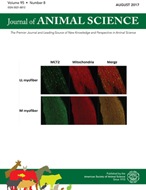-
Views
-
Cite
Cite
D. G. Morrison, P. E. Humes, N. K. Keith, R. A. Godke, Discriminant Analysis for Predicting Dystocia in Beef Cattle. II. Derivation and Validation of a Prebreeding Prediction Model, Journal of Animal Science, Volume 60, Issue 3, March 1985, Pages 617–621, https://doi.org/10.2527/jas1985.603617x
Close - Share Icon Share
Summary
Discriminant analysis was utilized to derive and validate a model for predicting dystocia using only data available at the beginning of the breeding season. Data were collected from 211 Chianina crossbred cows (2 to 6 yr old) bred to Chianina bulls. A proportionally stratified sampling procedure divided females into an analysis sample (n=134) on which the model was derived and a hold-out sample (n=77) on which the prediction model was validated (tested). Variables available during the derivation stage were cow age, cow weight, pelvic height, pelvic width, pelvic area and calf sire. Dystocia was categorized as either unassisted or assisted. Occurrence of dystocia was 17.2 and 18.2% in the analysis and hold-out samples, respectively. All data were standardized to a mean of zero and a variance of one before statistical analysis. The centroid of cows experiencing dystocia differed (P<.01) from that of cows calving unassisted in the analysis sample. Significant variables were pelvic area and cow age (standardized coefficients = .56 and .51, respectively). This model correctly classified 85.1% of the cows in the analysis sample. This was 13.5% greater than the proportional chance criterion. For model validation, prediction accuracy was 84.4% in the hold-out group, which was 14.2% greater than the proportional chance criterion. However, only 57.1% of the cows that experienced dystocia were correctly classified. Examination of the data revealed that those cows misclassified were 3 yr of age or older. All 2-yr-old, first-calf heifers (100%) that experienced dystocia were correctly classified in both the analysis and hold-out samples. In this study, discriminant analysis correctly classified a large percentage of cows into assisted and unassisted calving groups using a prebreeding prediction model.





